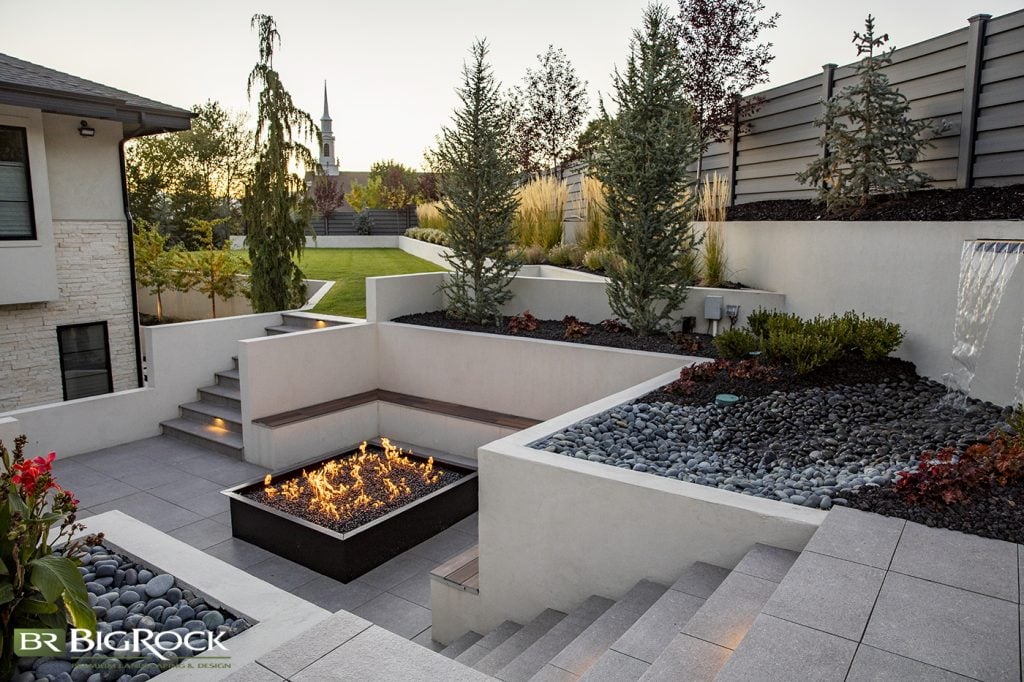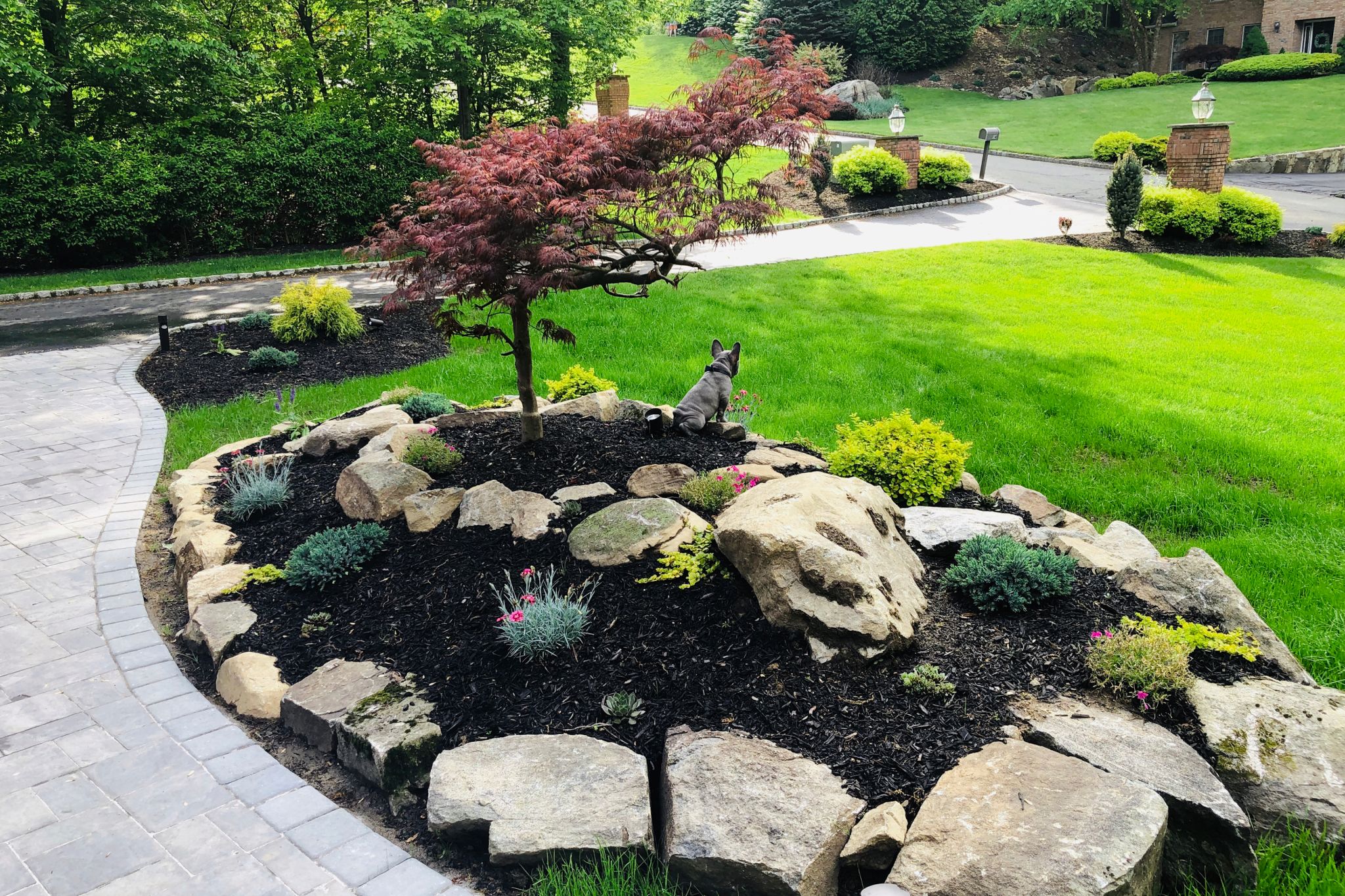Change Your Yard With Innovative Landscape Design Ideas and Strategies
Transforming a yard requires thoughtful factor to consider of its unique qualities. Effective landscape Design can enhance both functionality and aesthetic charm. By checking out various strategies, one can produce a room that not just shows personal design however also supports local biodiversity. As the journey unfolds, concerns about plant sustainability, selection, and layout develop, triggering a deeper exploration right into how to make these ideas revive.
Examining Your Outdoor Room: Comprehending Your Yard's Possible
Assessing outdoor space is essential for efficient landscape layout. Understanding the distinct attributes of a garden enables designers to maximize its potential. Factors such as dirt quality, sunlight exposure, and existing frameworks play an important role in establishing what can be achieved. Examining the topography helps determine locations for growing, paths, or water functions, while noting water drainage patterns guarantees that plants thrive without waterlogging.
Recognizing the yard's microclimates can influence plant choice and positioning. Observing just how the area is made use of by citizens educates useful Design choices, such as seating locations or play areas. Furthermore, considering the bordering environment and surrounding landscapes can provide inspiration and context for Design decisions. By extensively taking a look at these aspects, one can develop a natural and welcoming outdoor room that mirrors the owner's vision while integrating with nature. Ultimately, a complete evaluation prepares for a successful landscape Design job.
Choosing the Right Plants: A Guide to Shade, Texture, and Seasonal Rate of interest
When selecting plants for a landscape style, recognizing the interaction of color, appearance, and seasonal interest is crucial for producing a vibrant and vibrant yard. Color can stimulate emotions and set the tone for the space; consequently, choosing an unified palette boosts visual charm. Cozy tones like reds and oranges produce power, while cooler hues like blues and environment-friendlies supply peace.
Texture includes depth and measurement, permitting a mix of foliage shapes and dimensions. Incorporating fine-textured plants with bold-leaved ranges produces comparison and intrigue.
Seasonal rate of interest is essential for preserving year-round appeal. Selecting a range of plants that bloom in various periods assurances that the yard continues to be lively, changing from springtime's vivid blossoms to fall's rich vegetation. By attentively taking into consideration these elements, one can curate a landscape that is not just cosmetically pleasing however appealing and likewise diverse throughout the year.

Producing Practical Areas: Designing Spaces for Relaxation and Entertainment
Creating practical areas in a landscape Design boosts the functionality of outdoor rooms, permitting homeowners to perfectly mix relaxation and home entertainment. By thoughtfully separating areas right into unique zones, people can cater to various tasks, from silent resorts to lively events. A well-designed area might integrate a comfortable analysis nook nestled amongst lush greenery, giving a relaxing retreat (Landscape Architect). On the other hand, a vivid outdoor dining area can act as the ideal setting for events with friends and family
Tactically positioned pathways can lead guests in between these zones, making certain simple navigating. Additionally, including components like seating locations, fire pits, or water features can enhance the overall setting and capability. The integration of diverse textures and shades in each zone can produce aesthetic rate of interest while preserving a cohesive visual. Inevitably, developing practical areas allows property owners to optimize their outside experience, changing their yards into flexible areas that fulfill varied way of life demands.
Incorporating Hardscape Aspects: Patios, Walkways, and Focal Information
Integrating hardscape aspects right into landscape Design matches functional zones by supplying structure and visual allure. Patios function as necessary exterior space, enabling house owners to appreciate meals and gatherings in a specified area while improving access. The selection of products, such as natural rock or concrete, can greatly influence the overall aesthetic, blending flawlessly with the surrounding setting.
Pathways help with motion with the garden, assisting site visitors while including deepness and passion. These paths can be crafted from different materials, consisting of crushed rock, pavers, or brick, each contributing to the yard's character.
Centerpieces, such as decorative stones, sculptures, or water functions, draw the eye and create a sense of objective within the landscape. Purposefully placed, these elements can transform a normal yard into an intriguing area, inviting exploration and involvement. Through thoughtful integration of hardscape, a landscape comes to be not only practical but likewise aesthetically sensational.
Enhancing Personal Privacy and Safety And Security: Natural Barriers and Frameworks
To enhance privacy and safety in landscape design, the usage of all-natural barriers such as thick hedges can properly secure a home from undesirable sights. Furthermore, mounting privacy fences offers a solid framework that adds to a sense of security and seclusion. With each other, these elements develop an even more intimate outdoor area while preventing possible invasions.
Growing Thick Hedges
While lots of homeowners seek aesthetic appeal in their landscapes, growing thick hedges offers a dual function of enhancing privacy and safety. These natural barriers create an aesthetic shield, effectively blocking the sight from prying eyes and discouraging potential trespassers. Various types, such as boxwood, holly, or privet, can be selected for their development patterns and foliage density, ensuring lush coverage throughout the year. In addition, well-kept hedges can add to a relaxing atmosphere, taking in sound and supplying an environment for wild animals. The critical positioning of these bushes can define residential property borders and produce secluded exterior spaces, allowing home owners to enjoy their yards with a feeling of safety. Eventually, dense bushes are a reliable remedy for blending charm with capability.
Installing Privacy Fences
Privacy fences function as another effective technique for boosting personal privacy and safety and security in household landscapes. These structures not just define residential or commercial property boundaries but additionally develop a sense of privacy, shielding house owners from spying eyes. Different products, such as steel, wood, and plastic, offer distinct appearances and levels of sturdiness, permitting home owners to select based upon their Design choices and upkeep requirements.

Lasting Landscape Design: Eco-Friendly Practices for a Greener Yard
Lasting browse this site landscape design stresses the importance of native plant option and water conservation methods. By selecting plants that are well-adapted to the local environment, gardeners can lower maintenance and resource usage. Implementing effective watering approaches even more improves the yard's ecological advantages, advertising a much healthier ecological community.
Native Plant Selection
Indigenous plant choice plays an important duty in sustainable landscape design, advertising biodiversity and reducing the requirement for chemical inputs. By choosing plants indigenous to a details area, gardeners can create environments that support neighborhood wildlife, such as pollinators, birds, and hop over to here valuable bugs. These plants are adapted to the local environment and soil problems, requiring much less water and maintenance compared to non-native species. Furthermore, indigenous plants can help regulate erosion and improve dirt health and wellness, cultivating a balanced community. Incorporating indigenous species right into landscape makes not just improves the visual allure of the yard yet additionally adds to environmental strength. Ultimately, indigenous plant option is a vital technique for those looking for to cultivate a lively and sustainable garden.
Water Conservation Techniques
Incorporating indigenous plants can significantly enhance water preservation initiatives in landscaping. These plants are well-adapted to neighborhood environments, requiring less water and upkeep than non-native selections. Implementing drip watering systems permits targeted watering, lessening dissipation and overflow. Rainwater gathering systems can additionally be mounted, gathering and storing rain for garden use. Mulching aids retain soil moisture, minimizing the regularity of watering. Organizing plants with comparable water requires together develops effective watering areas, better conserving water. In addition, utilizing permeable products for paths permits rain to leak right into the ground, renewing groundwater products. By using these water preservation methods, gardeners can develop sustainable landscapes that flourish while decreasing ecological impact (Artificial Grass). Such methods contribute to a greener yard and a healthier community
Customizing Your Design: Adding One-of-a-kind Features and Individual Touches
Exactly how can one change a garden into a personal refuge? Personalizing a landscape Design includes integrating unique functions that mirror private preferences and lifestyles. One technique is to integrate individualized garden art, such as sculptures or handmade birdhouses, which can work as prime focus and discussion starters. On top of that, tailoring plant selections based you could look here upon seasonal blooms or personal choices can create a dynamic and progressing area.
Developing practical locations, such as a comfy reading space or an exterior eating space, can improve use and comfort. Integrating elements like a fire pit or a water feature can introduce a welcoming atmosphere.
Shade plans, structures, and materials must align with the property owner's style, whether it be contemporary, rustic, or diverse. Eventually, the goal is to develop a room that resonates with the individual's identity, making the yard not just an aesthetic joy yet a real expansion of the house owner's individuality.
Often Asked Inquiries
Exactly how Do I Allocate a Landscape Design Task?
To allocate a landscape Design task, one need to assess task extent, research study expenses for products and labor, focus on functions, and allot an added 10-20% for unexpected expenditures, ensuring a practical financial strategy.
What Equipment Are Vital for Home Garden Landscaping?
Crucial devices for home garden landscape design consist of a shovel, rake, garden fork, pruning shears, trowel, wheelbarrow, and hoe. These instruments aid in dirt prep work, planting, upkeep, and effective transportation of products throughout the landscape design job.
How Can I Keep My Yard After Upgrading?
To preserve an upgraded garden, normal watering, mulching, weeding, and trimming are important (Artificial Grass). Tracking plant health and wellness, adjusting dirt nutrients, and seasonal plant treatment add to a growing setting that showcases the garden's brand-new Design effectively
When Is the most effective Time to Beginning Landscape Design?
Can I DIY My Landscape Design or Should I Employ a Professional?
Individuals can absolutely DIY their landscape Design if they have creativity and fundamental abilities; nonetheless, employing a professional usually guarantees a more cohesive and experienced result, specifically for complicated jobs or particular Design goals.
Identifying the garden's microclimates can affect plant selection and placement. When choosing plants for a landscape style, comprehending the interaction of color, structure, and seasonal interest is crucial for creating a lively and vibrant yard. Selecting a selection of plants that flower in different periods guarantees that the yard continues to be dynamic, shifting from springtime's vibrant flowers to autumn's rich foliage. Incorporating indigenous varieties into landscape designs not only improves the visual appeal of the garden however likewise adds to ecological durability. Crucial tools for home yard landscaping consist of a shovel, rake, garden fork, trimming shears, trowel, hoe, and wheelbarrow.